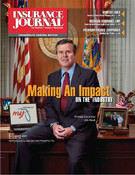Texas voters have an opportunity on Sept. 13 to remove the joker from an ingenious form of judicial poker that has pushed up insurance costs so high medical providers are being forced to restrict services.
Non-economic damages awards in tort lawsuits—the so-called “pain and suffering” club trial attorneys wield so effectively to inflate jury awards and lawsuit settlements for their clients—are targeted for severe restrictions in one of 22 constitutional amendments up for a vote on Sept. 13.
Proposition 12 would validate action taken by the legislature to limit recovery for “pain and suffering” resulting from injury by a medical provider to $250,000 per provider, with a maximum of $750,000 in damages from three or more providers.
It also would allow future legislatures, by a three-fifths vote, to expand this concept to other types of defendants, such as manufacturers and motor vehicle drivers.
Adoption of this proposition would bring under government regulation one of the few areas of commerce allowed to operate like a Wild West saloon poker game and would hopefully put an end to the medical malpractice insurance crisis that has left more than half of Texas’ counties with no licensed obstetrician.
Some critics compare the “pain and suffering” portion of jury awards in personal injury lawsuits to the lottery, because the plaintiff stands a chance to win a big jackpot if the jury reaches for a multi-million-dollar figure in determining damages the defendant must pay.
But I don’t think that’s an accurate analogy, because you can easily calculate your chances of winning the lottery, and if you win, you know how much money you will be paid. Neither is true for “pain and suffering awards,” where the sky is the limit and your odds depend on the skills of the attorneys involved.
Instead, I would compare “pain and suffering” awards to a poker game with no limits on betting and with the plaintiff always dealt a joker that could be any card the plaintiff chose. A game like that depends largely on the ability of the plaintiff attorney to bluff his or her opponents into paying a goodly sum of money to see a poker hand that always costs the defendants dearly.
Because of the unlimited scope of “pain and suffering” awards, and because trial attorneys’ compensation is based on a “piece of the action” in the form of a contingency fee that is usually about 40 percent of the total award, the amount of non-economic damages often determines whether the plaintiff’s attorney takes a financial bath on a case or makes a killing.
That financial reality has put increasing pressure on non-economic damages as the controlling strategy in personal injury cases. With few tools at their disposal, defense attorneys have been unable to offset the advantage offered to plaintiffs by the open-ended non-economic damages demands the law allows them to make.
During its fairly brief life—non-economic damage awards did not become well-established in the U.S. until the postwar economic boom in the 1950s allowed America to indulge in the luxury of a litigious society—this judicial invention has grown to be a major factor in our nation’s economy. Because all of these awards are paid by insurance companies, the result is inevitably increased insurance costs, and those, in turn, are passed along to consumers.
Some examples of this cost to our society:
—In 1989, the average non-economic award was $319,000. In 10 years, that figure leaped to $1,379,000.
—Since 2000, 17 of the 21 insurance companies providing medical malpractice coverage in Texas have stopped writing business.
—By one legal scholar’s estimate, about half of all money awarded in American tort cases each year is for “pain and suffering” awards. Based on current information, that translates to about $40 billion a year in “pain and suffering” awards.
—Half of the non-profit nursing homes in Texas have dropped their liability insurance because the cost became prohibitive.
This dilemma was brought to the attention of the most recent legislative session, and both houses overwhelmingly passed a comprehensive revision to tort laws that includes the caps on liability exposure for health care providers.
Our reasoning was based on the results in 24 other states that have passed similar laws. These states have more doctors per capita and slower increases in insurance rates than do states without these caps. Since California enacted limits 27 years ago, liability premiums have risen one-third as much as the national average.
“Pain and suffering” awards have clearly priced themselves out of the market in Texas. We can no longer afford the cost in higher insurance rates and restricted medical care. I hope the voters decide on Sept. 13 to shut down this destructive poker game.
Kim Brimer represents Tarrant County’s District 10 in the Texas Senate. He previously served in the Texas House of Representatives for 12 years and owned an independent insurance agency in Arlington for 25 years.
Topics Texas
Was this article valuable?
Here are more articles you may enjoy.


 Beryl’s Remnants Spawned 4 Indiana Tornadoes, Including an EF-3: NWS
Beryl’s Remnants Spawned 4 Indiana Tornadoes, Including an EF-3: NWS  FM Global Rebrands As FM
FM Global Rebrands As FM  Soccer Officials Arrested After Melee That Damaged Hard Rock Stadium in Miami
Soccer Officials Arrested After Melee That Damaged Hard Rock Stadium in Miami  Insurers Settle With Hotel in Case of Woman Videotaped in the Shower
Insurers Settle With Hotel in Case of Woman Videotaped in the Shower 


